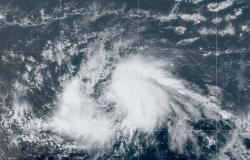Hear
NASA’s telescope James Webb managed to discover the galaxy closest to the beginning of the Universe called JADES-GS-z14-0which has the distinction of being the star cluster closest to the Big Bang.
JADES-GS-z14-0, in addition to its proximity to the origins of the cosmos, caught the attention of the scientific community for its brilliance; This is most likely related to the fact that it is made up of many young stars.
The galaxy discovered by James Webb is historically located in the 290 million years after the Big Bang explosion, so the importance of this discovery, which represents an age of just 2% after the creation of the Universe, is overwhelming.
The $10 billion James Webb Space Telescope (JWST) was released in 2021 as a joint venture between the US, European and Canadian space agencies.
It was specifically designed to explore much deeper into the cosmos and see much further back in time than any other astronomical tool. One of its key objectives is to find the very first stars that exploded during the birth of the universe.
According to the information offered by the official NASA site, Webb is the largest space telescope and complex ever built, will be able to collect light that has been traveling for 13.5 billion years, almost since the beginning of the universe. “Webb is a time machine that allows us to observe the first galaxies that formed after the ‘Big Bang’. Because it collects infrared light, it sees directly through the giant dust clouds that block the view of most other telescopes,” explains the specific section of the telescope.
This equipment has a segmented mirror set 21 feet wide (6.5 meters wide), and is powerful enough to look for water vapor in the atmospheres of planets orbiting other stars.
The James Webb Telescope was built to help understand how galaxies evolve over millions of years in large spirals, and to search for signs of habitability on distant planets.
The initials JADES is the name of the object, and corresponds in English to “JWST advanced deep extragalactic study.” It is one of several observation programs which uses the telescope to probe the first few hundred million years of the cosmos.
The third part of the name, “z14″, refers to “Redshift 14″. Redshift is the term astronomers use to describe distances. It is a measure of how light emanating from a galaxy distant was stretched to longer waves by the expansion of the Universe.
According to NASA experts, the presence of oxygen so early in the life of the galaxy JADES-GS-z14-0 It is a surprise and suggests that multiple generations of very large stars had already ended their lives before the galaxy was discovered.
THE NATION






